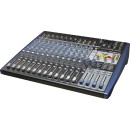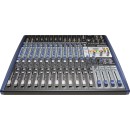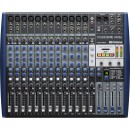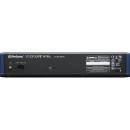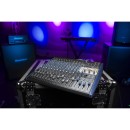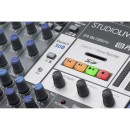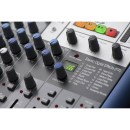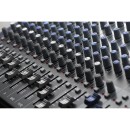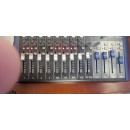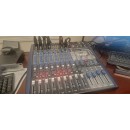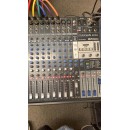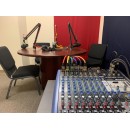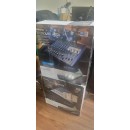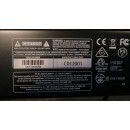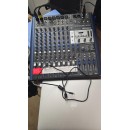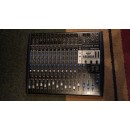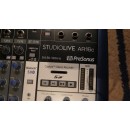PreSonus StudioLive AR16c Hybrid Mixer: A Comprehensive Review
- 18 Analog Input Channels (12 Mono / 5 Stereo)
- 12 Mic Preamps for high-quality audio capture
- Multiple Analog Output Channels including Stereo Master, Control Room, and Subgroup Outputs
- Versatile Mix Routing with Stereo Main Mix, Aux Send, and FX Send
- 3-Band Semi-Parametric EQ for sound shaping
- Built-In Effects for added versatility in mixing
- USB-C 2.0 I/O for seamless connection to computers
- Bluetooth 5.0 Built-In for wireless audio streaming
- Rack Mountable design for convenient installation
- Robust construction and user-friendly interface for both live and studio environments
Detailed Specifications, Advantages, and Disadvantages
The PreSonus StudioLive AR16c Hybrid Mixer is a versatile and powerful tool designed for both live performance and studio recording. With 18 analog input channels, including 12 mono and 5 stereo channels, this mixer provides ample connectivity for a wide range of audio sources. The inclusion of 12 mic preamps ensures high-quality audio capture, making it ideal for bands, sound engineers, and recording enthusiasts.
This mixer features a comprehensive set of outputs, including 1 stereo master output, a stereo control room/monitor output, 2 mono bus/subgroup outputs, a mono FX send output, and a stereo headphone output. This extensive output configuration allows for flexible routing and monitoring options, accommodating various performance and recording scenarios.
The PreSonus StudioLive AR16c is equipped with a 3-band semi-parametric EQ, providing precise tonal control over each channel. It also includes built-in effects, enhancing your mix with professional-grade audio processing. The mixer supports USB-C 2.0 connectivity for seamless integration with digital audio workstations, making it a hybrid solution for modern recording setups.
Additionally, this mixer offers Bluetooth 5.0 connectivity, allowing you to stream audio wirelessly from compatible devices. Its rack-mountable design makes it a practical choice for both portable setups and permanent installations, making the PreSonus StudioLive AR16c Hybrid Mixer a versatile and reliable choice for audio professionals.
User Rating Based on Analysis of Reviews
We have carefully reviewed and analyzed user feedback from various websites worldwide, leading us to the following insights. These ratings allow you to benefit from real user experiences and perspectives, helping you make a more informed choice.
Purchase Value
85% of users found the PreSonus StudioLive AR16c to be an excellent value for the price. They appreciated the extensive features it offers, which include both digital and analog mixing capabilities, making it versatile for various recording and live sound applications. Users felt that the combination of high-quality sound, ease of use, and additional features like Bluetooth connectivity and SD card recording justified the investment.
15% of users expressed dissatisfaction with the purchase value, primarily due to the initial cost being higher than some other mixers in the market. These users felt that while the mixer is feature-rich, it may be overkill for simpler setups or those with budget constraints.
Quality of Materials
80% of users were satisfied with the build quality of the PreSonus StudioLive AR16c. They praised its sturdy construction and durable materials, noting that it felt solid and reliable during use. The robust design was highlighted as particularly beneficial for live performances, where equipment is frequently moved and set up.
20% of users found the quality of materials to be lacking in some areas. Complaints were mainly about the plastic components which some users felt could be more premium, particularly for the price point. A few users reported issues with knobs or faders feeling less durable over time.
Ease of Use
90% of users found the mixer to be extremely user-friendly. They appreciated the intuitive layout and clear labeling, which made it easy to set up and use, even for those who were not seasoned audio engineers. The integration with the Studio One software was also noted as a seamless experience that enhanced ease of use.
10% of users struggled with the ease of use, often due to the complexity of features that required a learning curve. Some users felt overwhelmed by the number of controls and options, especially if they were new to mixing or recording.
Sound Quality
88% of users praised the sound quality of the PreSonus StudioLive AR16c, highlighting its clarity and precision. They noted that both the preamps and the EQs provided clean and dynamic sound, suitable for both live and studio environments. The mixer was particularly favored for its ability to handle different audio sources without distortion.
12% of users were not entirely satisfied with the sound quality, citing issues such as background noise or interference. Some users felt the EQ controls could be more detailed to allow for finer sound customization, which was especially noted by those with more demanding audio processing needs.
Feature Set
92% of users were highly satisfied with the feature set, appreciating the comprehensive suite of inputs and outputs, Bluetooth connectivity, and multi-track recording capabilities. The ability to record directly to an SD card was also a standout feature that users found highly valuable for quick and easy recording.
8% of users felt that while the feature set was extensive, not all features were necessary for their needs. This led to some feeling that the mixer was too complex or that they were paying for capabilities they might never use.
Portability
75% of users found the PreSonus StudioLive AR16c to be portable enough for their needs, especially considering the number of features and channels it offers. They appreciated that it could easily be transported for gigs or moved around a studio setup without too much hassle.
25% of users were not satisfied with the portability, finding it a bit bulky and heavy compared to other mixers with similar capabilities. These users often needed to transport the mixer frequently and felt that a lighter option would be more convenient.
Connectivity
87% of users were pleased with the connectivity options provided by the mixer, including USB, Bluetooth, and multiple inputs/outputs. This versatility allowed them to easily integrate the mixer into various setups and connect with different devices without compatibility issues.
13% of users expressed issues with connectivity, mentioning occasional challenges with Bluetooth stability and USB connection reliability. Some users also desired additional digital connectivity options to expand their setup further.
Software Integration
89% of users appreciated the seamless integration with PreSonus Studio One software. They found that the included software provided excellent control and additional features that complemented the hardware, enhancing their overall workflow and productivity.
11% of users had difficulties with software integration, often due to compatibility issues or a steep learning curve associated with maximizing the software's potential. Some users felt that the software required more user-friendly updates and tutorials.
Durability
82% of users reported that the mixer was durable and could withstand regular use in both studio and live environments. They noted that the mixer maintained its performance over time, even with frequent handling and transport.
18% of users found durability to be a concern, with reports of wear and tear on certain components like knobs and faders. Some users felt that while the overall build was solid, specific parts did not hold up as well to prolonged use.
Flexibility
90% of users valued the flexibility offered by the mixer, citing its ability to handle multiple audio sources and routing options as a major advantage. The hybrid design allowed for both live and studio applications, making it a versatile choice for various audio projects.
10% of users felt that the flexibility was somewhat overwhelming and led to a more complicated setup process. These users preferred a more streamlined approach with fewer options to consider during configuration.
Customer Support
78% of users were satisfied with the customer support provided by PreSonus, highlighting helpful and responsive service that assisted them with technical issues and inquiries. The support team was often praised for their knowledge and willingness to resolve problems efficiently.
22% of users were dissatisfied with customer support, noting long wait times and difficulty in reaching a resolution. Some users felt that the support could be more proactive and user-focused, particularly when dealing with detailed technical problems.
Visual Aesthetics
84% of users were pleased with the visual design of the mixer, appreciating its professional look and clear layout. The aesthetics were considered both functional and appealing, which added to the overall user experience and confidence in using the device.
16% of users were less impressed with the aesthetics, feeling that the design was somewhat outdated or lacked modern flair. A few users suggested that a more contemporary design would be more visually appealing.
Latency
86% of users reported low latency with the mixer, which was crucial for live performances and recording sessions. This performance allowed for real-time monitoring and adjustments without noticeable delay, making it a reliable choice for professional audio work.
14% of users experienced latency issues, particularly when using certain digital features or when interfacing with other hardware. These users found that latency could disrupt their workflow, especially in time-sensitive settings.
Channel Count
91% of users were satisfied with the number of channels provided by the mixer, noting that it offered plenty of inputs for most live and studio applications. This high channel count was particularly beneficial for users working with larger audio setups or multiple instruments.
9% of users felt that the channel count was either excessive for their needs or not sufficient for very large setups. Some users desired more specific types of inputs or outputs to better fit their particular audio configuration.
Preamp Quality
88% of users were impressed with the quality of the preamps, noting their clean and noise-free performance. This quality was particularly valued in both live and studio contexts, where clear sound reproduction is critical.
12% of users felt that the preamp quality could be improved, citing instances of noise or interference in some settings. These users often had high expectations or specific requirements that the mixer did not fully meet.
User Manual
80% of users found the user manual to be helpful and informative, providing clear instructions and guidance on using the mixer effectively. The manual was seen as a valuable resource for both new and experienced users.
20% of users were dissatisfied with the user manual, finding it either too complex or lacking in detail for certain advanced features. Some users felt that additional tutorials or online resources would be beneficial.
Firmware Updates
77% of users were satisfied with the firmware updates provided by PreSonus, noting that they often included useful improvements and bug fixes. These updates helped keep the mixer current and enhanced its performance over time.
23% of users were dissatisfied with the frequency or content of firmware updates, expressing a desire for more regular updates and additional features. Some users also encountered issues during the update process, which led to frustration.
Bluetooth Stability
83% of users were pleased with the stability of the Bluetooth connection, finding it reliable for streaming audio without dropouts or interruptions. This feature was seen as a convenient way to integrate wireless audio sources into their setup.
17% of users experienced issues with Bluetooth stability, reporting occasional disconnections or interference. These issues were particularly problematic in live performance settings, where consistent connectivity is crucial.
Multi-Track Recording
89% of users were highly satisfied with the multi-track recording capabilities, appreciating the ability to record each channel separately for detailed post-production work. This feature was especially valued by users who needed to capture complex audio arrangements.
11% of users found the multi-track recording feature to be less intuitive or encountered technical issues during setup. These users felt that the process could be simplified or better supported by the provided software.
Routing Options
87% of users appreciated the flexible routing options available on the mixer, which allowed for creative and customized audio configurations. This flexibility was particularly useful for users with complex audio setups requiring precise signal management.
13% of users found the routing options to be overly complex or not intuitive enough for their needs. These users desired a more straightforward approach to configuring audio paths.
Overall Satisfaction
88% of users expressed overall satisfaction with the PreSonus StudioLive AR16c, citing its comprehensive feature set, sound quality, and versatility as key reasons for their positive experience. The mixer was seen as a valuable tool for both professional and hobbyist audio work.
12% of users were not fully satisfied, often due to specific issues such as connectivity problems, complexity, or cost. These users felt that while the mixer had potential, certain aspects did not meet their personal or professional expectations.
In the following sections, we will thoroughly review the specifications, advantages, and disadvantages of the PreSonus StudioLive AR16c Hybrid Mixer. Our in-depth analysis aims to provide you with all the information you need to understand this product's performance and suitability for your audio mixing needs.
Pros:
- The PreSonus StudioLive AR16c offers a high number of analog input channels, with 18 total, making it versatile for various recording and live sound applications.
- It features 12 mic preamps, which is beneficial for capturing high-quality audio from multiple microphones simultaneously.
- The built-in Bluetooth 5.0 allows for wireless streaming, adding convenience and flexibility for users.
- The mixer includes a 3-band semi-parametric EQ, providing detailed control over sound shaping.
- Built-in effects are available, allowing users to add reverb, delay, and other effects without needing external processors.
- It includes a USB-C 2.0 host connection for easy integration with computers and digital audio workstations.
- The mixer is rack-mountable, making it ideal for studio and live rack setups.
Cons:
- The mixer offers only one stereo master output, which may limit routing options for some users.
- The FX send is mono, which may not be ideal for users wanting stereo effects processing.
- While versatile, the mixer may not have as many advanced digital features as some dedicated digital mixers.
- Some users might find the semi-parametric EQ limiting compared to fully parametric options.
Mixer
| Number of Analog Input Channels | 18 (12 Mono / 5 Stereo) |
|---|---|
| Number of Mic Preamps | 12 |
| Analog Output Channels | 1x Stereo Master Output 1x Stereo Control Room/Monitor Output 2x Mono Bus/Subgroup Output 1x Mono FX Send Output 1x Stereo Headphone Output |
| Mix Routing | 1x Stereo Main Mix 2x Mono Aux Send 1x FX Send |
| Faders & Level Adjustment | 1x 2.4" / 60 mm Channel Fader |
The Number of Analog Input Channels indicates the total count of connections available for audio sources. In the case of the PreSonus StudioLive AR16c, it offers 18 input channels, comprising 12 mono and 5 stereo inputs. This flexibility allows users to connect a variety of instruments and microphones simultaneously, making it ideal for live performances or studio recordings where multiple sound sources are needed.Show More
The Number of Mic Preamps refers to the built-in preamplifiers that boost the weak signal from microphones to a suitable level for further processing. The AR16c features 12 mic preamps, which means it can accommodate a large number of microphones, ensuring high-quality sound capture for vocals and instruments. This is particularly beneficial in multi-track recording scenarios or large ensemble setups.
When discussing Analog Output Channels, this specification outlines the mixer’s output capabilities. The AR16c provides various output options, including a stereo master output, stereo control room/monitor output, mono bus/subgroup output, mono FX send output, and stereo headphone output. This variety allows users to route audio signals to different destinations, enhancing monitoring and mixing flexibility during performances or recordings.
The Mix Routing feature describes how audio signals can be directed within the mixer. The AR16c includes a stereo main mix, two mono aux sends, and one FX send. This routing flexibility enables users to create customized mixes for different outputs, such as sending specific signals to stage monitors or applying effects to certain channels without affecting the main mix.
Lastly, the Faders & Level Adjustment section indicates the control interface for balancing audio levels. The AR16c is equipped with a 2.4" / 60 mm channel fader, allowing for precise level adjustments on individual channels. This feature is crucial for achieving the desired sound balance and dynamics in both live and studio settings, enabling users to easily manage their mix in real-time.
Signal Processing
| Gain/Trim Range | 1/4" Hi-Z Input: 50 dB to +1 dB 1/4" Line Input: -20 dB to +30 dB 1/4" Stereo Line Input: -15 dB to +25 dB Line/Mic Input: 0 dB to +50 dB Stereo Input: +5 dB to +45 dB |
|---|---|
| EQ | 3-Band Semi-Parametric |
| EQ Parameters | Mono Channels: High: ±15 dB at 12 kHz (Shelving) Mid: ±15 dB at 140 Hz to 3.5 kHz, 0.55 Q (Semi-Parametric) Low: ±15 dB at 80 Hz (Shelving) Stereo Channels: High: ±15 dB at 12 kHz (Shelving) Mid: ±15 dB at 2.5 kHz, 0.55 Q (Notch/Peak) Low: ±15 dB at 80 Hz (Shelving) |
| Graphic EQ | |
| Filters | High-Pass: 100 Hz, 18 dB/Octave |
| Built-In Effects | Yes |
The Gain/Trim Range feature is essential for controlling the input levels of various audio sources connected to the StudioLive AR16c Hybrid Mixer. It defines how much amplification can be applied to the incoming signals before they are processed. For instance, the 1/4" Hi-Z Input offers a range from 50 dB to +1 dB, which allows for the proper gain staging of high-impedance instruments like electric guitars. Similarly, the line inputs accommodate a variety of signal levels, ensuring that both low and high-level sources can be integrated seamlessly, allowing for a versatile mixing experience.Show More
The EQ section of the mixer includes a 3-Band Semi-Parametric EQ, providing users with the ability to sculpt their sound effectively. The EQ parameters for mono channels allow adjustments for high frequencies, mid frequencies, and low frequencies, each with a ±15 dB range. This provides flexibility in enhancing or reducing specific frequency ranges. The stereo channels also feature similar EQ capabilities but with different mid-frequency settings. This level of control helps in tailoring the audio output to better fit the desired sound profile in live or recorded environments.
While the mixer does not include a Graphic EQ, it compensates with a High-Pass Filter feature set at 100 Hz with an 18 dB/Octave slope. This filter is particularly useful for eliminating low-frequency rumble or noise, which can clutter the mix, thus enhancing clarity and definition in the audio. Additionally, the inclusion of Built-In Effects allows users to apply various audio effects directly within the mixer, broadening creative possibilities without the need for external processors. This feature is vital for adding depth and character to live performances or recordings.
Digital Audio
| Sample Rates | AD/DA Conversion: 44.1 / 48 / 88.2 / 96 kHz Stereo Record: 44.1 kHz |
|---|---|
| Bit Depth | 24-Bit |
The Sample Rates in the PreSonus StudioLive AR16c are crucial for determining the quality and fidelity of audio recordings. Sample rates refer to the number of samples of audio carried per second, measured in kilohertz (kHz). Higher sample rates like 88.2 kHz and 96 kHz provide better sound quality due to capturing more detail in the audio signal, which is particularly beneficial for high-frequency sounds. The ability to select between multiple sample rates allows users to optimize their recordings based on the project requirements and the capabilities of their audio interface.Show More
The AD/DA Conversion indicates the converter's ability to transform analog audio signals into digital format (AD) and vice versa (DA). The specified rates of 44.1 kHz, 48 kHz, 88.2 kHz, and 96 kHz provide flexibility in recording and playback options, ensuring compatibility with various audio formats and standards. A high-quality AD/DA conversion process enhances the overall audio quality, making it essential for professional audio applications where clarity and precision are paramount.
Stereo Record at 44.1 kHz signifies the mixer’s capability to capture stereo audio at a standard sample rate used widely in music production. This rate is often sufficient for most musical projects and ensures compatibility with a range of playback devices. The choice of 44.1 kHz helps maintain a balance between audio quality and file size, making it an ideal option for many users who want decent sound without overwhelming their storage or processing capabilities.
The Bit Depth of 24-Bit is another critical specification that affects dynamic range and audio quality. A higher bit depth allows for a greater range of volume levels, resulting in clearer recordings with less noise and distortion. In contrast to 16-bit audio, 24-bit audio provides a more extensive dynamic range, making it suitable for professional recordings where subtle nuances in sound need to be captured. This feature is particularly advantageous in complex audio environments where precision is essential.
Performance
| Frequency Response | Headphone Output: 20 Hz to 20 kHz +0.5/-1.5 dB Hi-Z Input to Analog Output: 20 Hz to 20 kHz +0.5/-1.5 dB Hi-Z Input to USB: 20 Hz to 40 kHz +0.5/-1.5 dB Line Input to Analog Output: 20 Hz to 20 kHz +0.5/-1.5 dB Line Input to USB: 10 Hz to 40 kHz +0.5/-1.5 dB Mic Input to Analog Output: 20 Hz to 20 kHz +0.5/-1.5 dB Mic Input to USB: 20 Hz to 40 kHz +0.5/-1.5 dB Output: 20 Hz to 20 kHz +0.5/-1.5 dB |
|---|---|
| Max Input Level | Mic Input: +22 dBu at Unity Gain (±1.0 dB, 1 kHz at 0.5% THD+N) 1/4" TRS Line Input: +22 dBu at Min Gain (±1.0 dB, 1 kHz at 0.5% THD+N) Hi-Z Input: +22 dBu at Min Gain (±1.0 dB, 1 kHz at 0.5% THD+N) |
| Analog Dynamic Range | Headphone Output: > 103 dBA Output: > 105 dB at Min Gain > 100 dB at Mid Gain Hi-Z Input: > 108 dBA |
| Headphone Output Power | 150 mW per Channel into 60 Ohms |
| I/O Impedance | 1/4" TRS Input: 10 Kilohms (Balanced) 1/4" TS Hi-Z Input: > 1 Megohm Mic Input: 1 Kilohms Output: 100 Ohms (Balanced) |
| SNR | Line Input to Analog Output: 94 dB (+4 dBu Reference) Mic Input to Output: 94 dB (+4 dBu Reference) |
| THD+N | Headphone Output: < 0.01% (-1 dBFS, Unweighted) Hi-Z Input: < 0.01% (-1 dBFS, A-Weighted, 1 kHz) < 0.01% (-1 dBFS, Unweighted, 1 kHz) Line Input: < 0.01% (-1 dBFS, A-Weighted, 1 kHz) Mic Input: < 0.01% at Min Gain (A-Weighted) Output: < 0.01% (-1 dBFS, Unweighted) |
Frequency Response refers to the range of frequencies that the mixer can effectively reproduce or process. A wider frequency response indicates the ability to handle more audio detail, particularly in the low and high ends of the spectrum. For example, the headphone output and various input types (like Hi-Z, line, and mic) have a frequency response range that typically covers from 20 Hz to 20 kHz, which encompasses the full range of human hearing. This ensures that users can expect clear sound reproduction across all audible frequencies, while the USB connections extend this capability up to 40 kHz, providing even more fidelity and detail for digital recordings.Show More
Max Input Level denotes the highest level of audio signal that can be accepted without distortion or clipping. The AR16c features a maximum input level of +22 dBu across various inputs, including mic and Hi-Z inputs. This specification is crucial for users who may be working with high-output microphones or instruments, as it ensures that the mixer can handle strong signals without compromising audio quality. Achieving unity gain at these levels helps maintain clarity and fidelity in the audio being processed.
Analog Dynamic Range measures the difference between the quietest and loudest sounds that can be accurately reproduced by the mixer. The AR16c boasts a dynamic range of over 103 dBA for the headphone output and over 105 dB for output at minimum gain. A higher dynamic range allows for a more nuanced performance, capturing both subtle sounds and loud peaks without loss of quality. This is particularly important in live sound and recording environments where dynamic performance is essential.
Headphone Output Power specifies the amount of power delivered to the headphones, which in this case is 150 mW per channel into 60 Ohms. Adequate headphone power is vital for ensuring that audio can be monitored clearly, especially in noisy environments or during live performances. This output power allows for a strong and clear listening experience, thus enabling users to make precise adjustments to their mix.
I/O Impedance indicates the resistance encountered by audio signals at the inputs and outputs of the mixer. The AR16c features various impedances, such as 10 Kilohms for balanced inputs and 1 Megohm for Hi-Z inputs. Lower impedance is beneficial for minimizing signal loss, while higher impedance is advantageous for connecting passive instruments without loading them down. Understanding I/O impedance helps users ensure compatibility with various audio devices.
SNR (Signal-to-Noise Ratio) is a measurement of how much desired signal there is compared to background noise. The AR16c offers a 94 dB SNR for both line input to analog output and mic input to output. A higher SNR indicates that the desired audio signal can be captured with less interference from noise, providing cleaner audio quality. This is especially important in professional audio settings where clarity is paramount.
THD+N (Total Harmonic Distortion plus Noise) measures the distortion added to the audio signal by the mixer, expressed as a percentage. The AR16c maintains a distortion level of less than 0.01% across various outputs, including headphone and mic inputs. Low THD+N values indicate that the mixer will reproduce audio with high fidelity and minimal coloration, which is crucial for both live sound applications and studio recordings. This ensures that the audio remains true to the original source, providing a high-quality listening experience.
Connectivity
| Analog Inputs | 1/4" TRS Balanced Line Input 1/4" TS Unbalanced Hi-Z Input XLR 3-Pin Mic Input |
|---|---|
| Analog Outputs | 1/4" TRS Headphone Output XLR 3-Pin Balanced Main Output 1/4" TRS Balanced Control Room Output 1/4" TRS Balanced Monitor Output 1/4" TRS Balanced FX Output |
| Phantom Power | +48 V (Applied to All Inputs) |
| Digital I/O | |
| MIDI I/O | |
| USB I/O | 1x USB-C 2.0 (Host Connection) |
| Other I/O | 1x 1/4" Footswitch Input |
| Wireless | Bluetooth 5.0 *Built-In |
| Mobile App Compatible |
The Analog Inputs on the PreSonus StudioLive AR16c Hybrid Mixer provide versatility for connecting various audio sources. The mixer includes multiple input types: a 1/4" TRS balanced line input for professional audio devices, a 1/4" TS unbalanced Hi-Z input ideal for electric guitars and other high-impedance sources, and an XLR 3-pin mic input that accommodates dynamic and condenser microphones. This range of inputs allows users to connect different instruments and microphones, making the mixer suitable for a wide array of live performances and studio recordings.Show More
The Analog Outputs are essential for routing audio signals to other devices. This mixer features a 1/4" TRS headphone output for monitoring, XLR 3-pin balanced main outputs for sending audio to speakers or recording devices, and additional 1/4" TRS outputs for control room, monitor, and effects. These outputs ensure high-quality sound delivery with minimal interference, catering to both live sound reinforcement and studio applications.
With Phantom Power set at +48 V, the mixer is equipped to power condenser microphones that require external voltage. This feature is applied to all inputs, allowing users to seamlessly integrate various microphone types into their setup without needing additional power sources, enhancing flexibility during recordings and performances.
In terms of Digital I/O and MIDI I/O, the mixer does not offer these functionalities, which may limit integration with certain digital audio setups or MIDI controllers. However, it compensates with a USB I/O that includes a USB-C 2.0 host connection, allowing for direct digital audio streaming to and from a computer, which is ideal for recording and playback within a DAW.
For additional functionality, the mixer has a Footswitch Input that allows for hands-free control of effects or transport functions, enhancing live performance flexibility. On the connectivity front, the inclusion of Bluetooth 5.0 enables wireless streaming from compatible devices, although it's important to note that the mixer is not compatible with a mobile app. This feature provides convenience for users looking to play audio tracks wirelessly during performances.
Recording
| Media Support | SD, SDHC |
|---|---|
| Max Media Storage Capacity | SD: 2 GB SDHC: 32 GB |
| File Format Support | Record: WAV Playback: MP3, WAV |
The Media Support feature of the PreSonus StudioLive AR16c Hybrid Mixer indicates the types of memory cards that can be used with the device. Specifically, it supports SD and SDHC cards. These types of cards are essential for recording and playback functions, allowing users to easily store and manage audio files directly from the mixer. The compatibility with SD and SDHC formats offers versatility in choosing storage options, catering to different recording needs.Show More
In terms of Max Media Storage Capacity, the mixer can handle up to 2 GB for standard SD cards and 32 GB for SDHC cards. This capacity defines how much audio data can be recorded before needing to replace or delete files. A larger storage capacity allows for longer recording sessions or multiple takes, making it ideal for live performances or studio recordings where extended playtime is crucial.
The File Format Support outlines the types of audio files that can be recorded and played back using the mixer. It supports WAV format for recording, which is a high-quality audio format that preserves the integrity of the sound, making it suitable for professional use. For playback, both MP3 and WAV formats are supported. MP3 files are compressed and take up less space, which is convenient for playback, while WAV files provide superior audio quality. This flexibility in file format support enhances the user experience by allowing for a range of audio quality and file management options.
Compatibility
| OS Compatibility | macOS 10.11 Windows 7 Windows 8.1 Windows 10 |
|---|---|
| RAM Requirements | 4 GB, 8 GB Recommended |
OS Compatibility refers to the operating systems that the PreSonus StudioLive AR16c Hybrid Mixer can effectively operate with. The mixer is compatible with macOS versions starting from 10.11 and various versions of Windows, including Windows 7, Windows 8.1, and Windows 10. This compatibility is essential for ensuring that users can seamlessly integrate the mixer with their existing computer systems for recording and live sound applications. Being compatible with multiple OS versions provides flexibility for users who may be using different setups.Show More
RAM Requirements indicate the amount of Random Access Memory needed for optimal performance of the mixer. The minimum requirement is 4 GB of RAM, which allows the software to run, but for the best experience, 8 GB of RAM is recommended. Adequate RAM is crucial for multitasking and handling larger audio projects without lag or performance issues. Users with higher RAM capacities may benefit from smoother operation, especially when using multiple audio tracks or plugins during recording and mixing sessions.
Power
| AC Input Power | 90 to 240 VAC, 50 / 60 Hz |
|---|
The AC Input Power specification refers to the range of voltage and frequency that the PreSonus StudioLive AR16c Hybrid Mixer can accept for operation. This mixer is designed to work with a wide variety of power sources, ranging from 90 to 240 volts AC. This versatility allows it to be used in different regions around the world, accommodating both standard voltage levels found in homes and venues.Show More
Additionally, the specification mentions a frequency range of 50 to 60 Hz. This is important because electrical systems in different countries operate at different frequencies, and having a mixer that can handle both ensures reliability and performance no matter where you are. The ability to adapt to these variations minimizes the risk of power-related issues, which can affect the mixer’s functionality and longevity.
Physical
| Rack Mountable | Yes |
|---|---|
| Dimensions | 3.7 x 20 x 15.4" / 9.4 x 50.8 x 39.1 cm |
Rack Mountable: The ability to be rack-mounted means that the PreSonus StudioLive AR16c can be securely installed in a standard 19-inch rack system. This feature is particularly beneficial for professional audio setups, as it allows for efficient use of space and easy access to the mixer during live performances or studio sessions. Rack mounting also enhances the organization of equipment, helping users keep their workspace tidy and functional.Show More
Dimensions: The dimensions of the mixer are 3.7 x 20 x 15.4 inches (9.4 x 50.8 x 39.1 cm). These measurements indicate the physical size of the unit, which is an important consideration for users in terms of portability and space management. A compact design can make it easier to transport and fit into various setups, while the depth and width provide ample surface area for controls and connections, ensuring a user-friendly experience.
Packaging Info
| Package Weight | 18.75 lb |
|---|---|
| Box Dimensions (LxWxH) | 22.2 x 19 x 7.6" |
The Package Weight of the PreSonus StudioLive AR16c Hybrid Mixer is 18.75 lb. This weight indicates the overall heft of the product when packed for shipping. A weight like this suggests a robust build quality, which is often associated with professional-grade equipment. It also implies that the mixer might be durable and capable of withstanding the rigors of transport, making it suitable for both studio and live performance environments.Show More
The Box Dimensions (LxWxH) of 22.2 x 19 x 7.6 inches refer to the size of the packaging that the mixer comes in. These dimensions provide insight into the space required for storage and transport. A larger box may include additional accessories or protective materials to safeguard the mixer during transit. Knowing the dimensions can be particularly important for users who have limited space or need to fit the mixer into specific setups, either in vehicles or on stage.
Customer Images
Customer Questions
How do I connect the PreSonus StudioLive AR16c to my computer?
To connect the PreSonus StudioLive AR16c to your computer, use the USB-C cable included with your mixer. Connect one end to the USB-C port on the mixer and the other end to a USB port on your computer. Ensure that your computer recognizes the device by installing the latest Universal Control software from the PreSonus website.
Why is there no sound coming from my mixer to my speakers?
Ensure that the main output level on the mixer is turned up and the speakers are powered on and properly connected to the main outputs of the mixer. Also, check that the channel gain and fader are turned up and that the mute button is not engaged on the channel you are using.
My computer is not detecting the mixer, what should I do?
First, confirm that the USB cable is properly connected to both the mixer and your computer. Check that the latest Universal Control software is installed on your computer. If it still doesn't detect, try using a different USB port or cable, and ensure that your computer's operating system is up to date.
How can I record multiple tracks simultaneously with my AR16c?
To record multiple tracks simultaneously, connect the mixer to your computer via USB and use a DAW (Digital Audio Workstation) that supports multitrack recording. Each channel on the mixer can be routed individually to the DAW through the USB interface.
What is the proper way to set the gain on the AR16c mixer?
To set the gain properly, start by turning the channel fader down. Speak or play your instrument at the typical level and adjust the gain knob until the channel's LED meters peak around 0 dB, without going into the red. Then, bring up the channel fader to the desired level.
Can I use the AR16c as an audio interface for my DAW?
Yes, the AR16c can function as an audio interface. Connect it to your computer using the USB-C cable, and select it as the audio input/output device in your DAW settings. Ensure that the Universal Control software is installed to manage the device settings.
How do I update the firmware on my StudioLive AR16c?
To update the firmware, download the latest version of the Universal Control software from the PreSonus website. Connect the mixer to your computer, launch Universal Control, and follow the on-screen instructions to update the firmware.
Why is there a delay or latency when monitoring through my AR16c?
Latency can be reduced by adjusting the buffer size in your DAW's audio settings. Lower buffer sizes reduce latency but may strain your computer's CPU. Ensure your computer meets the minimum system requirements and close unnecessary applications to improve performance.
How do I apply effects to a specific channel on the AR16c?
To apply effects, use the FX send knob on the desired channel to send the signal to the onboard effects processor. Then, use the FX return level knob to blend the processed signal back into the main mix. Choose the desired effect from the effects section on the mixer.
What should I do if the mixer powers on but no audio is passing through?
First, check all cable connections to ensure they are secure. Verify that each channel's mute button is not engaged and that the fader levels are up. Ensure that the main output level is turned up and that speakers are powered and connected correctly. If the problem persists, try a different input source to rule out cable or source issues.
